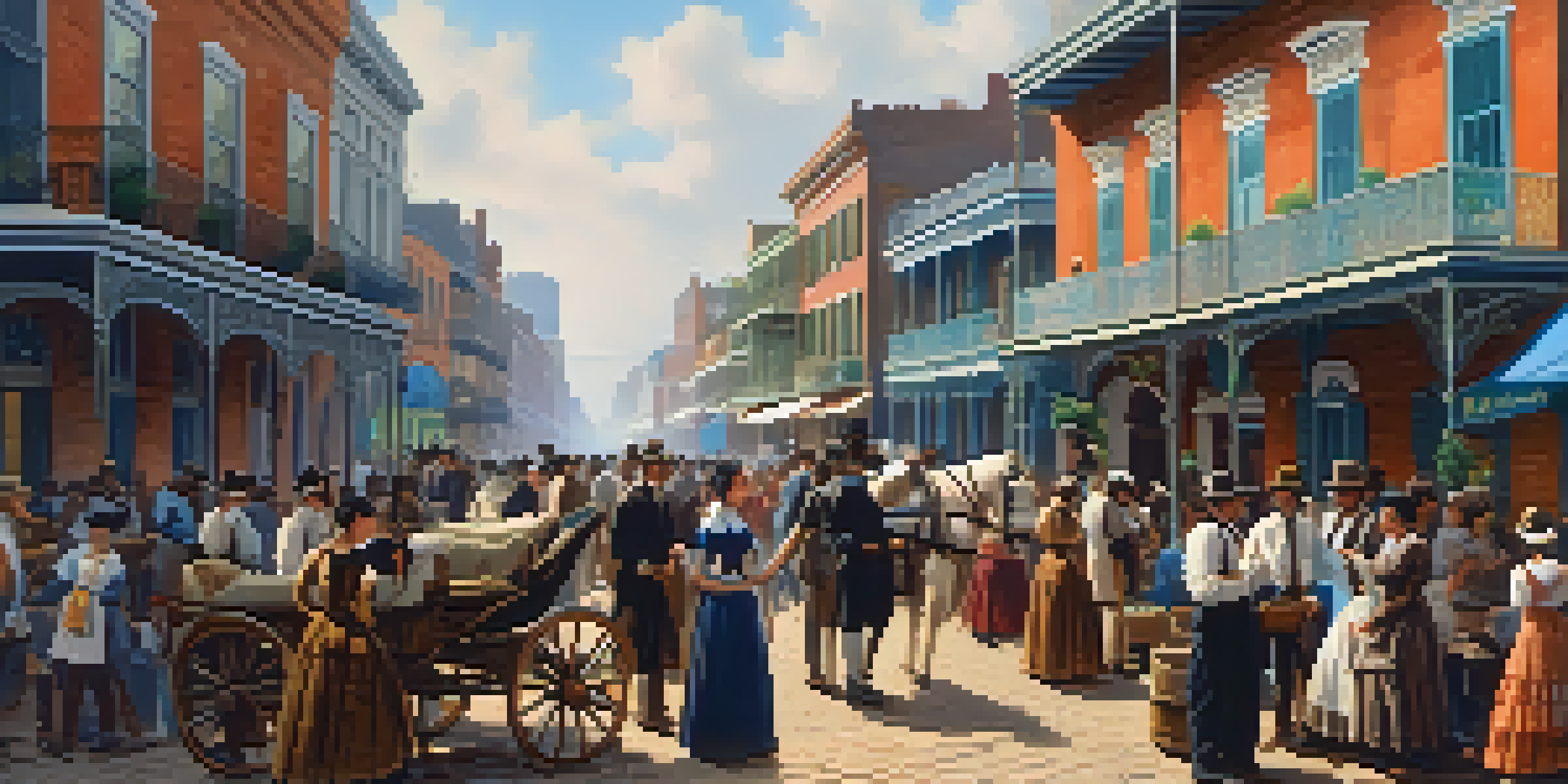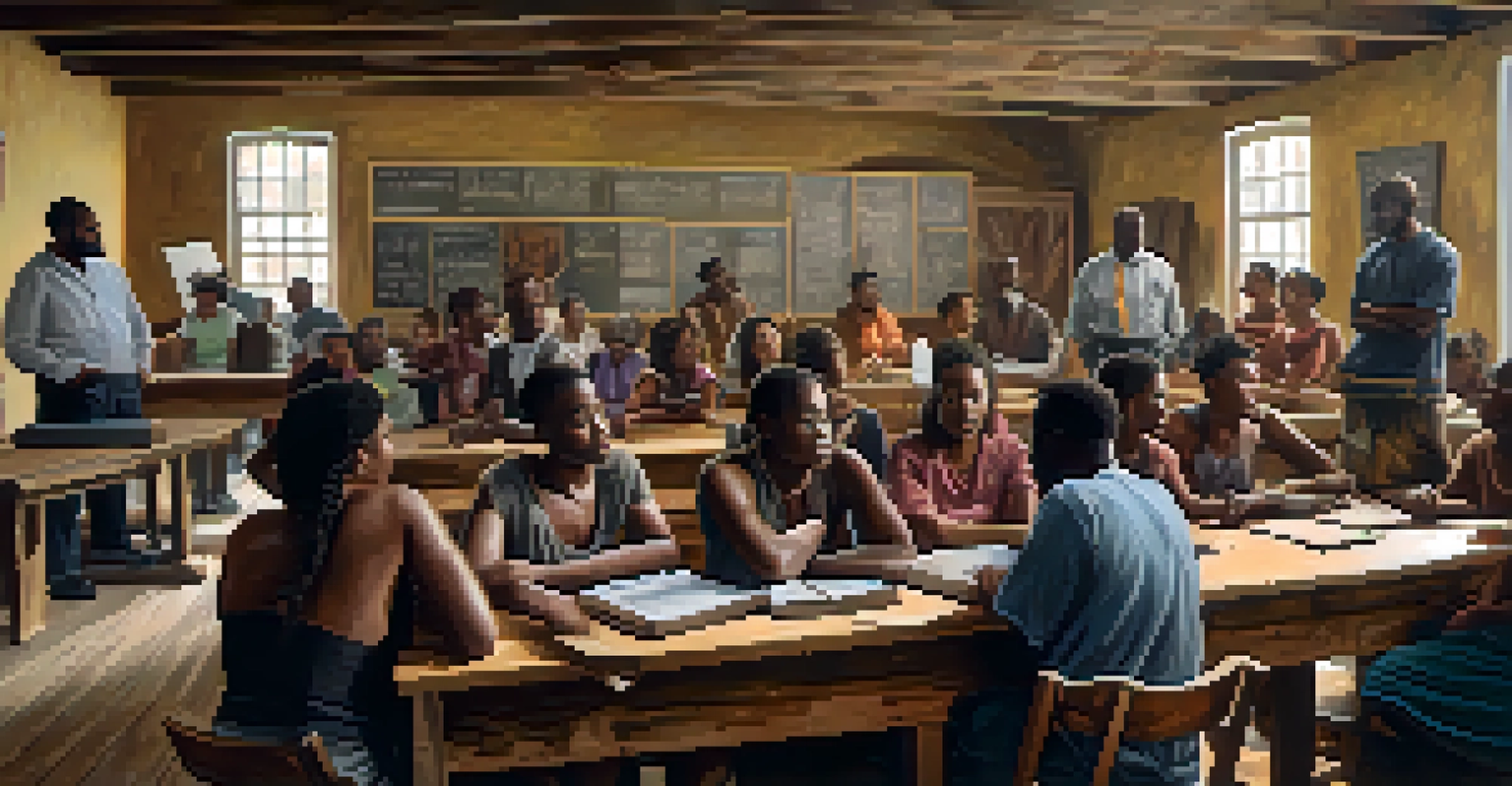New Orleans During the American Civil War: A Timeline

The Antebellum Era: New Orleans on the Brink of War
Before the Civil War, New Orleans was a bustling hub of commerce and culture, deeply entwined with the Southern economy. The city thrived on trade, particularly in cotton and sugar, and its port was one of the busiest in the nation. However, the 1860 election of Abraham Lincoln, perceived as a threat to slavery, heightened tensions and pushed the city closer to conflict.
A house divided against itself cannot stand.
The growing rift between North and South was palpable in New Orleans, where many residents strongly supported the Confederacy. This support was fueled by a sense of Southern identity and the economic benefits that slavery provided to the region. As whispers of secession grew louder, the atmosphere became charged with anticipation and fear.
By early 1861, the political climate had shifted dramatically, setting the stage for conflict. The secession of Louisiana from the Union in January was a pivotal moment, as it solidified New Orleans' allegiance to the Confederacy and marked a clear division in the nation. The city's fate was now irrevocably tied to the war that would soon engulf the entire country.
The Capture of Forts Jackson and St. Philip: A Turning Point
In April 1862, Union forces launched a significant naval campaign to take control of New Orleans by capturing Forts Jackson and St. Philip. These forts guarded the Mississippi River, serving as crucial defensive structures for the Confederacy. The Union's victory would not only open the city to occupation but also disrupt Confederate supply lines.

The Union Navy, led by Admiral David Farragut, successfully bypassed the forts, demonstrating the power of naval warfare in modern conflict. This strategic maneuver was a shock to Confederate forces and marked a turning point in the war. As the Union ships steamed towards New Orleans, panic spread among the city's residents and defenders.
New Orleans: A City Divided
Before the Civil War, New Orleans was deeply divided along pro-Union and pro-Confederate lines, reflecting broader national tensions.
By April 25, 1862, New Orleans had fallen into Union hands, marking a significant blow to the Confederacy. The city, once a proud symbol of Southern resistance, was now occupied by Union troops. This occupation would change the daily lives of New Orleanians and set the stage for the complex relationship between the occupiers and the local population.
Union Occupation: Life Under Northern Control
The Union occupation of New Orleans brought significant changes to the city, both socially and economically. Many residents initially resented the presence of Union troops, leading to tensions and occasional violence. However, a surprising number of New Orleanians supported the Union cause, hoping for an end to the war and a return to stability.
The past is never dead. It's not even past.
During this period, the Union implemented measures to maintain order and support the local economy. They sought to rebuild infrastructure and stabilize markets, which had been disrupted by the war. Despite the challenges, some local businesses thrived under Union patronage, showcasing the resilience of New Orleans' entrepreneurial spirit.
However, the occupation was not without its difficulties. The Union faced constant challenges from Confederate sympathizers, and a pervasive atmosphere of distrust lingered in the air. The complexities of life in an occupied city were palpable, as residents navigated the fine line between collaboration and resistance.
The Role of Free People of Color and Enslaved Individuals
New Orleans had a unique demographic makeup, with a significant population of free people of color and enslaved individuals. The Civil War era brought new opportunities and challenges for these groups. Many free people of color supported the Union and sought to fight for their rights, while enslaved individuals began to resist their conditions in various ways.
The Union's arrival in New Orleans created a shift in the social landscape, as many enslaved people escaped to Union lines, seeking freedom and refuge. Some even enlisted in the Union Army, contributing to the fight for their liberation. This movement not only changed their lives but also altered the dynamics of the city itself.
Union Occupation Altered Lives
The Union occupation of New Orleans transformed the social and economic landscape, leading to both resistance and unexpected support from locals.
However, the journey towards freedom was fraught with uncertainty. While some found solace and hope, others faced harsh realities, including the threat of re-enslavement. The struggle for dignity and rights continued, illustrating the resilience of those who fought against oppression during this tumultuous time.
Economic Shifts: The Impact of War on Trade and Commerce
The Civil War had a profound impact on New Orleans' economy, disrupting its thriving trade and commerce. With the Union blockade in place, goods that once flowed freely through the port became scarce. This scarcity led to inflation and hardship for many residents, altering the economic landscape of the city.
Despite these challenges, some businesses adapted and found ways to survive. Speculators took advantage of the situation by hoarding goods, while others turned to smuggling to bypass the blockade. This underground economy showcased the ingenuity and determination of New Orleanians, even in the face of adversity.
As the war continued, the economic landscape evolved, reflecting the shifting tides of conflict. The rise of new industries, such as manufacturing for the war effort, began to reshape the city's economy. This transformation laid the groundwork for New Orleans' eventual recovery and growth in the post-war years.
The Fall of New Orleans: A Symbol of Southern Defeat
The fall of New Orleans in 1862 was not just a military defeat for the Confederacy; it was a symbolic blow to Southern pride. The city had long been seen as a stronghold of Southern culture and resistance. Its capture by Union forces represented a significant step towards the eventual downfall of the Confederacy.
As the Union established control, the Confederate government faced growing challenges. The loss of New Orleans disrupted supply lines and morale for Confederate troops. This shift in power dynamics underscored the reality that the war was taking a toll on the South, both economically and psychologically.
Legacy of the Civil War Today
The lasting impact of the Civil War continues to shape New Orleans' cultural identity and historical narrative, influencing its modern community.
The fall of New Orleans marked a turning point in the war, shifting the course of history. The city's occupation lasted until the end of the war, and its significance as a strategic location only grew. New Orleans became a focal point in the struggle for control of the Mississippi River, further entwining its fate with the broader conflict.
Reconstruction: Healing and Rebuilding After the War
After the Civil War ended in 1865, New Orleans entered a challenging period of Reconstruction. The city faced the daunting task of rebuilding not only its infrastructure but also its social fabric. The end of slavery brought new opportunities for freed individuals, but it also led to tensions and conflict as the city sought to redefine itself.
During Reconstruction, the city experienced significant changes, including the establishment of new rights for African Americans. Schools, churches, and organizations began to emerge, fostering a sense of community and empowerment. However, the struggle for equality faced resistance from those who wished to maintain the status quo.

The legacy of the Civil War would linger in New Orleans for years to come. The city's journey towards healing was complicated by political strife and social unrest. Yet, the resilience of its residents and their commitment to building a more just society would ultimately shape the future of New Orleans.
Legacy of the Civil War: New Orleans Today
The impact of the Civil War is still felt in New Orleans today, shaping its cultural identity and historical landscape. The city's rich tapestry of history reflects the scars and triumphs of its past. Memorials, museums, and educational programs continue to engage residents and visitors in conversations about this pivotal time in American history.
Modern New Orleans celebrates its diverse heritage, embracing the stories of those who lived through the war. From music to cuisine, the influences of various cultures can be seen in the city's vibrant community. This blend of history and culture serves as a reminder of the resilience and spirit of the people who have called New Orleans home.
As we reflect on the legacy of the Civil War, it is important to acknowledge the ongoing journey towards reconciliation and understanding. New Orleans stands as a testament to the complexities of American history, inviting us to learn from the past as we move forward into the future.